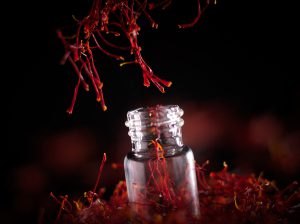Crocin is a bioactive compound that occurs naturally in some medicinal plants, especially saffron. Various conventional and new methods are used for its extraction. In the conventional method, this bioactive compound can be extracted by solvent extraction, solvent steam, or hydro distillation and maceration (2). The conventional extraction methods are usually non-selective (1) and time-consuming (4). They require a large amount of organic solvents and damage heat-sensitive bioactive chemicals (1).
As a result, novel extraction strategies have been developed for the recovery of bioactive constituents from saffron that reduce extraction time and solvent consumption while improving extraction yield and quality (8). It has been confirmed that the targeted bioactive components can be extracted more efficiently in terms of solvent volume and extraction time compared to conventional methods when the proper extraction method is used (7).
According to El Asbahani et al. (3), the extraction method should be chosen based on the desired bioactive component, heat sensitivity, tissue complexity, etc. These current extraction processes, known as “green methods,” are environmentally friendly, safer, faster, more efficient, and more precise (6). To obtain saffron’s bioactive components such as crocin, picrocrocin, and safranal, a wide range of solvents, including water, organic solvents, and their combinations, have been utilized (2). In general, fewer polar chemicals (safranal) are extracted with carbon dioxide, while initially, polar substances (crocin, crocetin) are extracted with organic solvents (e.g., ethanol) (5).
1- Ahmed, S., Hasan, M.M., Heydari, M., Rauf, A., Bawazeer, S., Abu-Izneid, T., Rebezov, M., Shariati, M.A., Daglia, M. and Rengasamy, K.R., 2020. Therapeutic potentials of crocin in medication of neurological disorders. Food and Chemical Toxicology, 145, p.111739.
2- Ali, A., Kousar, S., Khalid, W., Maqbool, Z., Aziz, A., Arshad, M.S., Aadil, R.M., Trif, M., Qin, H. and Manzoor, M.F., 2022. Crocin: Functional characteristics, extraction, food applications and efficacy against brain related disorders. Frontiers in Nutrition, p.3015.
3- El Asbahani, A., Miladi, K., Badri, W., Sala, M., Addi, E.A., Casabianca, H., El Mousadik, A., Hartmann, D., Jilale, A., Renaud, F.N.R. and Elaissari, A., 2015. Essential oils: From extraction to encapsulation. International journal of pharmaceutics, 483(1-2), pp.220-243.
4- Garcia-Vaquero, M., Rajauria, G. and Tiwari, B., 2020. Conventional extraction techniques: Solvent extraction. In Sustainable seaweed technologies (pp. 171-189). Elsevier.
5- Goleroudbary, M.G. and Ghoreishi, S.M., 2016. Response surface optimization of Safranal and Crocin extraction from Crocus sativus L. via supercritical fluid technology. The Journal of Supercritical Fluids, 108, pp.136-144.
6- Lee, K.X., Shameli, K., Yew, Y.P., Teow, S.Y., Jahangirian, H., Rafiee-Moghaddam, R. and Webster, T.J., 2020. Recent developments in the facile bio-synthesis of gold nanoparticles (AuNPs) and their biomedical applications. International journal of nanomedicine, pp.275-300.
7- Manzoor, M.F., Hussain, A., Sameen, A., Sahar, A., Khan, S., Siddique, R., Aadil, R.M. and Xu, B., 2021. Novel extraction, rapid assessment and bioavailability improvement of quercetin: A review. Ultrasonics Sonochemistry, 78, p.105686.
8- Rahaman, A., Kumari, A., Farooq, M.A., Zeng, X.A., Hassan, S., Khalifa, I., Aadil, R.M., Jahangir Chughtai, M.F., Khaliq, A., Ahmad, N. and Wajid, M.A., 2021. Novel extraction techniques: an effective way to retrieve the bioactive compounds from saffron (crocus sativus). Food Reviews International, pp.1-29.
.

